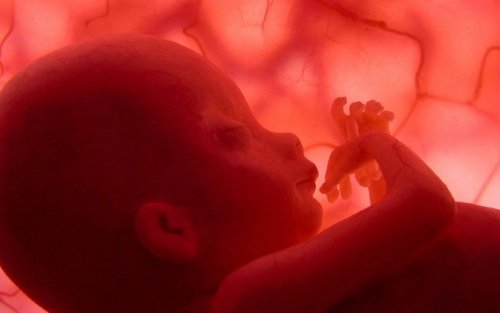What Are Molar Pregnancies?

Molar pregnancies are gestational abnormalities that don’t reach the end of the cycle. They occur when the product of fertilization becomes a cluster of cysts that grows rapidly.
In technical terms, the trophoblasts, which are the cells forming in the placenta, reproduce uncontrollably and form what is called a hydatidiform mole.
These atypical pregnancies can be complete or partial:
- It’s complete if the mass doesn’t include embryonic formation.
- It’s partial when an embryo is found in addition to the mass of cysts.
- Twins may also be present, sharing space with the cysts.
This type of pregnancy usually occurs because of genetic errors. In the case of complete molar pregnancy, one or two sperm fertilize an empty egg, and the genetic contribution comes from the father as a whole.
In the case of the partial molar, there is genetic material from the mother, but the father’s genetic material is duplicated. The final result is an embryo with 69 chromosomes instead of what is considered normal: 46.
In partial molar pregnancies, unfortunately the embryos will not develop and will be outgrown by the abnormal growths.
How often do these types of situations occur? Approximately between 0.5 and 1 cases per 1,000 pregnancies.
Risk factors for molar pregnancy
The following are considered risk factors:
- Pregnancy in women over 40 years of age. Pregnancies in this age group have shown a higher incidence of hydatidiform moles.
- Having had a previous molar pregnancy.
- Pregnant women who have suffered a spontaneous abortion.
- Nutritional deficiencies such as little protein in the diet and lack of carotene (vitamin A).
- Assisted fertility treatments.

How are molar pregnancies and their symptoms detected?
In general, the pregnant mother will feel typical signs of pregnancy, such as amenorrhea, nausea and abdominal growth.
Symptoms that don’t fit with a healthy pregnancy usually begin to emerge and reveal the need for control and diagnosis.
Some of these signs are:
- Loss of blood through the vagina or tissue in the form of a cluster
- Nausea and vomiting
- High blood pressure
- Swelling of lower extremities
- Anemia
- Ovarian cysts
- Very large or very small uterus
- Lack of fetal activity, such as movements in the uterine sac and heartbeat.
Either way, a specialist will have the ability to require an analytical search for high levels of the pregnancy hormone hCG.
By performing a pelvic analysis and ultrasound, they can detect the abnormal size of the uterus and the formation of clusters and an embryo.
Molar pregnancies usually occur because of genetic errors.
How are molar pregnancies medically treated?
Molar pregnancies often lead to spontaneous abortions. To avoid this, they must be removed surgically, by curettage or with medication.
In any case, these are pregnancies that either don’t have an embryo or, if they do, the embryo has no chance of surviving.
After removing the molar tissues, it’s possible for traces to remain, and thus a risk that they’ll reproduce again. This proliferation of abnormal tissue produces persistent gestational trophoblastic neoplasia.
This situation occurs in a percentage of 15 to 20% in complete molar pregnancies and 5% in partial ones.
Molar pregnancies usually lead to spontaneous abortions. To avoid this, they must be removed by surgery, by curettage or with medication.
Possible complications of molar pregnancies
The situation caused by molar pregnancies can be complicated.
- In the face of possible complications in these atypical pregnancies, an opportune diagnosis allows the woman to conserve her reproductive health and increases the possibilities of a future normal pregnancy.
- On the one hand, the mole is able to deeply penetrate into the uterine tissue, causing pain and bleeding with vaginal discharge. In molar pregnancies, the fetus doesn’t grow.

- On the other hand, when gestational trophoblastic neoplasia appears, there is a high chance of developing choriocarcinoa destruens, a type of cancer. This is attacked with chemotherapy, and depending on its severity, it may be necessary to perform a hysterectomy.
- Preeclampsia is another possibility if, due to the mole, blood pressure starts to rise.
- Another rare complication affects the thyroid gland.
What to do after a molar pregnancy?
A woman who has experienced this failed pregnancy is able to re-conceive if the diagnosis and treatment were timely, and always under medical supervision.
Usually, the obstetrician will recommend waiting a year, during which time you should check that there are no remains of the mole in order to preserve the health of the reproductive system.
Molar pregnancies are gestational abnormalities that don’t reach the end of the cycle. They occur when the product of fertilization becomes a cluster of cysts that grows rapidly.
In technical terms, the trophoblasts, which are the cells forming in the placenta, reproduce uncontrollably and form what is called a hydatidiform mole.
These atypical pregnancies can be complete or partial:
- It’s complete if the mass doesn’t include embryonic formation.
- It’s partial when an embryo is found in addition to the mass of cysts.
- Twins may also be present, sharing space with the cysts.
This type of pregnancy usually occurs because of genetic errors. In the case of complete molar pregnancy, one or two sperm fertilize an empty egg, and the genetic contribution comes from the father as a whole.
In the case of the partial molar, there is genetic material from the mother, but the father’s genetic material is duplicated. The final result is an embryo with 69 chromosomes instead of what is considered normal: 46.
In partial molar pregnancies, unfortunately the embryos will not develop and will be outgrown by the abnormal growths.
How often do these types of situations occur? Approximately between 0.5 and 1 cases per 1,000 pregnancies.
Risk factors for molar pregnancy
The following are considered risk factors:
- Pregnancy in women over 40 years of age. Pregnancies in this age group have shown a higher incidence of hydatidiform moles.
- Having had a previous molar pregnancy.
- Pregnant women who have suffered a spontaneous abortion.
- Nutritional deficiencies such as little protein in the diet and lack of carotene (vitamin A).
- Assisted fertility treatments.

How are molar pregnancies and their symptoms detected?
In general, the pregnant mother will feel typical signs of pregnancy, such as amenorrhea, nausea and abdominal growth.
Symptoms that don’t fit with a healthy pregnancy usually begin to emerge and reveal the need for control and diagnosis.
Some of these signs are:
- Loss of blood through the vagina or tissue in the form of a cluster
- Nausea and vomiting
- High blood pressure
- Swelling of lower extremities
- Anemia
- Ovarian cysts
- Very large or very small uterus
- Lack of fetal activity, such as movements in the uterine sac and heartbeat.
Either way, a specialist will have the ability to require an analytical search for high levels of the pregnancy hormone hCG.
By performing a pelvic analysis and ultrasound, they can detect the abnormal size of the uterus and the formation of clusters and an embryo.
Molar pregnancies usually occur because of genetic errors.
How are molar pregnancies medically treated?
Molar pregnancies often lead to spontaneous abortions. To avoid this, they must be removed surgically, by curettage or with medication.
In any case, these are pregnancies that either don’t have an embryo or, if they do, the embryo has no chance of surviving.
After removing the molar tissues, it’s possible for traces to remain, and thus a risk that they’ll reproduce again. This proliferation of abnormal tissue produces persistent gestational trophoblastic neoplasia.
This situation occurs in a percentage of 15 to 20% in complete molar pregnancies and 5% in partial ones.
Molar pregnancies usually lead to spontaneous abortions. To avoid this, they must be removed by surgery, by curettage or with medication.
Possible complications of molar pregnancies
The situation caused by molar pregnancies can be complicated.
- In the face of possible complications in these atypical pregnancies, an opportune diagnosis allows the woman to conserve her reproductive health and increases the possibilities of a future normal pregnancy.
- On the one hand, the mole is able to deeply penetrate into the uterine tissue, causing pain and bleeding with vaginal discharge. In molar pregnancies, the fetus doesn’t grow.

- On the other hand, when gestational trophoblastic neoplasia appears, there is a high chance of developing choriocarcinoa destruens, a type of cancer. This is attacked with chemotherapy, and depending on its severity, it may be necessary to perform a hysterectomy.
- Preeclampsia is another possibility if, due to the mole, blood pressure starts to rise.
- Another rare complication affects the thyroid gland.
What to do after a molar pregnancy?
A woman who has experienced this failed pregnancy is able to re-conceive if the diagnosis and treatment were timely, and always under medical supervision.
Usually, the obstetrician will recommend waiting a year, during which time you should check that there are no remains of the mole in order to preserve the health of the reproductive system.
All cited sources were thoroughly reviewed by our team to ensure their quality, reliability, currency, and validity. The bibliography of this article was considered reliable and of academic or scientific accuracy.
- Embarazo molar. Protocolos SEGO. Prog Obstet Ginecol 2004; 47 (8): 400-4.
-
Calero F. Enfermedad trofoblástica gestacional. Actual Obstet Ginecol 1989; 1:3.
- Mangili G, Lorusso D, Sechl M, et al.: Trophoblastic disease review for diagnosis and management. International Journal of Gynecological Cancer 2014; 24, 53: S109-S116.
This text is provided for informational purposes only and does not replace consultation with a professional. If in doubt, consult your specialist.








